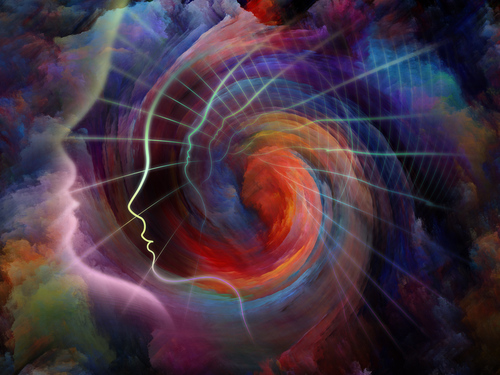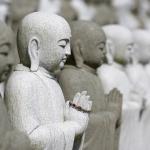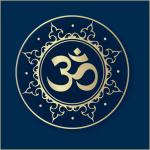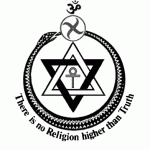Life After Death
Death and After Death States
Theosophy teaches that after a person dies, the Ego and its non-physical bodies undergo a process consisting of multiple stages before reincarnating. The process may be very brief (as in young children or cases of premature death) or it can be as long as 3,000 years. Theosophical literature, particularly the Mahatma Letters, has extensive teachings about the after-death states, some of which have received validation in parapsychological studies in the past century or so.

Life Span. Each person is born with a certain quantity of life-energy, like the oil in a lamp. When the oil is exhausted the person dies even if apparently healthy. When, however, the life-energy is not exhausted and the person meets a violent death, then the Ego continues to be conscious and alive, minus the physical body.
There is a distinction therefore between a natural death and a premature death. The latter is of three kinds: death accidentally, murder, and suicide. Each of these will undergo a different after-death process depending upon the circumstances of the death. These shall be separately discussed below.
Physical Death. The last organ to die, according to the Mahatma Letters (Mahatma Letter to AP Sinnett), is the brain. At the moment of death, a person recalls one's entire life in a span of a few seconds. "The dying brain dislodges memory with a strong, supreme impulse. . . . That impression and thought which was the strongest naturally becomes the most vivid and survives so to say all the rest which now vanish and disappear for ever, to reappear but in Devachan." (Mahatma Letters 93B)
This recall has been affirmed by recent research conducted on near-death experiences, such as those of Dr. Richard Moody. The last dominant thoughts of a person will determine the “life principle” of one's future existence, and the nature of these thoughts will depend upon the predominant character during the person's life.
There is lucidity at the moment of death even among madmen, as the process of life recall is undergone. The Mahatma Koot Hoomi therefore admonishes people to keep silence when a person is dying to avoid disturbing the thoughts and processes that will mold the Ego's future life.
There is a non-physical silver cord that connects the physical body and the kama-rupa (desire body). When this is broken, death becomes permanent. This cord has been observed by clairvoyants since the ancient times. The Bible refers to this in the book of Ecclesiastes 12:5-6: "Because man goeth to his long home, and the mourners go about the streets: Or ever the silver cord be loosed, or the golden bowl be broken. . . ."

At the moment of death, an apparition of the person just died may be seen by people at a distance. This is the involuntary projection of the mental illusory body or mayavi rupa. The image is based on the perception of the dying person; hence the apparition is often seen in the clothes they wear at the moment of death. Blavatsky says if the dying person is drowning, the image will appear as if dripping with water. This is different from the apparitions of dead people due to the "reflections in the astral light" and not due to the projection of the illusory body ( Mahatma Letter Appendix I).
The Separation of the Principles
To understand what follows after physical death, one must be familiar with the seven human principles: the physical body the etheric double (linga arira), life energy (prana), the desire or emotional body (kama-rupa), the mind (manas), the spiritual soul (buddhi) and the spirit (atma).

Above is a tabular form the classifications adopted by the Buddhist and Vedantic teachers of the human principles
In the case of a normal death, the lowest three principles are separated from the higher four. These three are the physical body, the etheric double (linga arira), and prana. There is a loss of consciousness and the entity will be in its kama rupa or desire/emotional body. The environment where it enters into is called kama-loka or the desire-world. The Ego goes into sleep and loses all recollection until it reawakens in Devachan. Those who know that they are physically dead, says the Mahatma Letters, are either Adepts or sorcerers. This stage in kama-loka may last from a few hours to several years, depending upon the Ego, the nature of death, and other factors.
It then goes into a long period of "gestation" where it prepares for entry into devachan. The length of this period has been described by the Mahatma KH as dependent upon one's "spiritual stamina."
Second Death At the end of the gestation period, the entity will now undergo a “second death” when the lower two principles will separate from the higher two, that is, kama-rupa together with the mental body will now detach from the Atma-Buddhi. In this process of separation there is a struggle that will determine how much of the mental body will go with the Atma-Buddhi, and how much with the kama-rupa. Upon separation, the kama-rupa and mental body becomes a “shell” that will gradually disintegrate in time. These shells are the "spirits" contacted by mediumistic seances.
In very rare cases where the person is extremely selfish, the entire mental body may be drawn towards the kama-rupa, thus depriving the Atma-Buddhi with the necessary vehicle for future incarnations. This is what is called a "lost soul," an intelligent being in kama-loka which is destined for annihilation because it is no longer linked to its immortal source, the Atma-Buddhi. When the wickedness is of a "spiritual, refined" nature, such a soul goes to Avichi, the antithesis of Devachan, which is often said to be the earth itself. The lost soul may still retain a lot of life-energy, however, and can even incarnate again and again until its vitality is exhausted. As a shell, it may also become a Dweller of the Threshold that gets attracted to a new personality that is formed by the former parent Ego (Atma Buddhi). There is still a possibility of re-linking between the soul and its parent Ego when there is the slightest spark of repentance in it. Lost souls that become non-entities, however, and which do not deserve Avichi, slid down to the Eighth Sphere, a globe denser than the earth and is spoken of as the "furnace of nature" where the materials of the soul are recast for future development.
Devachan
The purer part of the mental body that goes with the Atma-Buddhiis the Ego that will reincarnate in a subsequent life. After the "second death" the Ego enters into the Devachanic state which is blissful, where no traces of sorrow can enter. It is oblivious of what is happening in the physical world. The Ego may stay in Devachan for ten to thirty centuries, depending upon the wealth of experience of the preceding physical life. Devachan however is not the same as the heaven of Christians. It is a subjective state where the unfulfilled yearnings of the Ego are realized.
When the Ego enters Devachan, the shell which is left behind develops "a kind of hazy consciousness of its own from what remains in the shadow of personality." (Mahatma Letters 93B)
When the devachanic rewards come to an end, the ego then forms another mental and emotional vehicle drawn from the life-atoms of the preceding life. These atoms, also called tanhic elementals, await the Ego as it leaves Devachan, and will determine the type of personality the Ego will have in the succeeding life. (ML 93b)
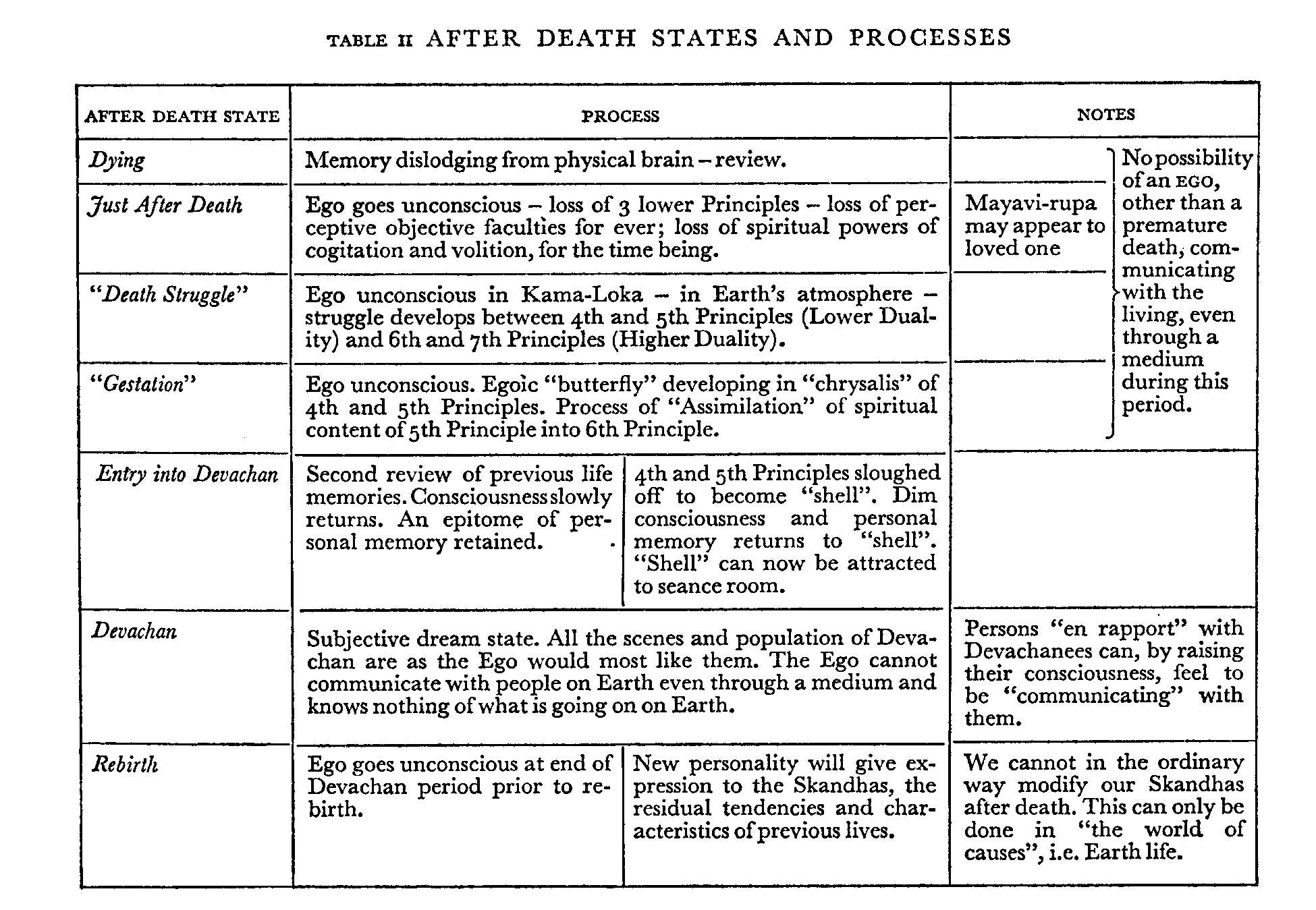
Premature deaths.
With premature deaths, accidents, murder, and suicide, the fates of the Egos after death are different. Their death-hour has not come, and their reservoir of life-energy has not been exhausted. They are not actually “dead” but only have lost their physical bodies as a vehicle. They may retain consciousness and can hence communicate with the living. They are also called Elementaries, Earth bound souls, or "Earth-walker."
The Mahatma Letters mention that the after-death states of those who died prematurely differ according to the circumstances of their death. Those who died of accidental death and which are "good and innocent Egos" will have no recollection of the accident and enter into a sleeping state (with happy dreams or without) until the time of its natural death. When they do dream, they "move and live among their familiar friends and scenes."
Those who die due to fits of temporary insanity similarly go into a state of slumber. Those which are sensual and selfish, on the other hand, "suffer all the tortures of a horrible nightmare," and will wander about and drawn by mediums who open up opportunities for gratifying their desires. The extreme cases become Piachas or virtual demons that incite living human beings to crimes. "The majority neither very good nor very bad, the victims of accident or violence (including murder) some sleep , others be come Nature pi achas, while a small minority may fall victims to mediums and derive a new set of skandhas from the medium who attracts them." (Mahatma Letters 76)
Suicides, who tried to escape their suffering, only find themselves still alive and conscious without a physical body, regretting their actions, and thus suffer with intensity.
The Mahatma Letters specifically mention the case of Guiteau, the assassin who killed President Garfield, and who was later executed. "Guiteau is gone into a state during the period of which he will be ever firing at his President, thereby tossing into confusion and shuffling the destinies of millions of persons; where he will be ever tried and ever hung. Bathing in the reflections of his deeds and thoughts especially those he indulged in on the scaffold." (Mahatma Letters L 70-C)
Communication with the Dead
As a general rule, communication with the dead is not possible due to the unconscious state of the Ego in kama-loka. Later, when the Ego awakens in Devachan, the gap between Devachanic consciousness and normal consciousness prevents such contact. However, there are exceptions to this rule, such as the following:
- When the person died prematurely, such as in accident, murder, or suicide. Under these circumstances, while the after-death states are not all uniform, contact is possible in some cases.
- When the consciousness of a living person is drawn to the consciousness of the person just died before its entry into the "gestation" period.
- When a purified living person can elevate his or her consciousness to the Devachanic level and communicate with the Ego in Devachan.
Egos that have gone on to Devachan. These shells may still retain memories and qualities of the deceased personality, and hence when contacted by mediums may appear to have intelligence. The real Ego, however, have already detached itself from the kama-rupa once it enters Devachan.
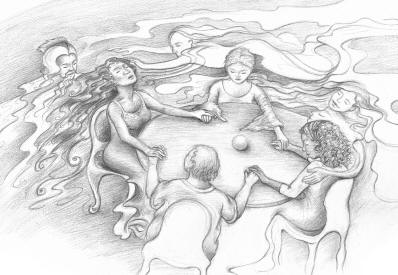
The claimed communications with the dead among spiritualist is actually communication with the?kama-rupa?or astral shells of the Egos that have gone on to Devachan. These shells may still retain memories and qualities of the deceased personality, and hence when contacted by mediums may appear to have intelligence. The real Ego, however, has already detached itself from the kama-rupa once it enters Devachan.
The Mahatma Letters strongly warns against the attempts of mediums to contact the Elementaries. "Woe to those whose Trishna [thirst] will attract them to mediums, and woe to the latter, who tempt them with such an easy Upadana [material cause for existence]. For in grasping them, and satisfying their thirst for life, the medium helps to develop in them is in fact the cause of a new set of Skandhas [attributes], a new body, with far worse tendencies and passions than was the one they lost." (ML 68)
The Death Experience
The experience of dying men by drowning and other accidents brought back to life, has corroborated our doctrine in almost every case. Such thoughts are involuntary, and we have no more control over them than we would over the eye's retina to prevent it from perceiving that colour which affects it most. At the last moment, the whole life is reflected in our memory and emerges from all the forgotten nooks and corners, picture after picture, one event after the other. The dying brain dislodges memory with a strong supreme impulse, and memory restores faithfully every impression entrusted to it during the period of the brain's activity. That impression and thought which was the strongest naturally becomes the most vivid and survives so to say all the rest which now vanish and disappear for ever, to reappear but in Devachan. No man dies insane or unconscious, as some physiologists assert. Even a mad man, or one in a fit of delirium treatment will have his instant of perfect lucidity at the moment of death, though unable to say so to those?present. The man may often appear dead. Yet from the last pulsation, from and between the last throbbing of his heart and the moment when the last spark of animal heat leaves the body the brain thinks and the Ego lives over in those few brief seconds his whole life over again. Speak in whispers, ye, who assist at a death-bed and find yourselves in the solemn presence of Death. Especially have you to keep quiet just after Death has laid her clammy hand upon the body. Speak in whispers, I say, lest you disturb the quiet ripple of thought, and hinder the busy work of the Past casting its reflection upon the Veil of the Future. - Mahatma Koot Hoomi, ML-93B
Near-Death Experience
In recent years the testimony of hundreds of people who have experienced "clinical death" have been collected and published by medical researchers, the best known being Dr. Raymond Moody (author of Life After Life) and Dr. Kubler Ross (author of On Death and Dying).
The experiences of these people who were revived and lived to tell what happened to them when they were "dead", bear a striking similarity to those described in Theosophical literature. For most, the first experience is the passing through a dark enclosure, before their consciousness refocuses, and they become aware of themselves, in a hard-to-define spiritual body, from which they watch, in a detached way, their physical body being revived on the operating table or rescued from a wrecked car. Many then find themselves in a world of light and freedom, in which they meet a "being of light" which epitomizes perfect understanding and perfect love. Often they experience an incredibly vivid instant review or replay of their lives and understand that they must return to complete the unfinished business of this incarnation. Many were reluctant to do so, and all testified (including the actor Peter Sellers and other well-known individuals) that the experience entirely changed their lives. They no longer had any fear of death and understood that, from this time on, their mission was to cultivate love for others and to go on learning, to the end of life.

